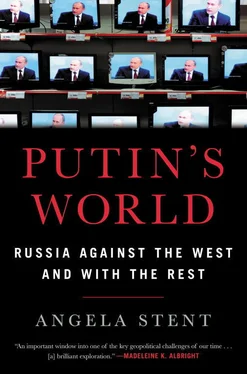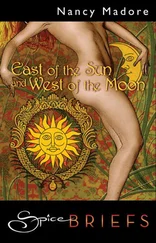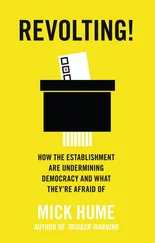Under Putin, Russian policy in Eurasia has had three main goals. The first is to pursue the economic and political integration of its neighbors via the newly-created Eurasian Economic Union and through upgrading the existing Collective Security Treaty Organization. The second is to expand Russian influence in the region through the use of “soft” power instruments, such as the organization Russky Mir (Russian World) and the World Congress of Compatriots Living Abroad, which promote Moscow’s interests through Russian-language teaching and Kremlin-friendly electronic media. The third is using economic (mainly energy) or military pressure against those states seeking to exit Russia’s influence and integration via the frozen conflicts or direct military aggression, as in Ukraine. Remittances are another form of leverage. More than 25 percent of the GDP of Kyrgyzstan and Tajikistan comes from remittances from migrant labor in Russia, and the economies of Uzbekistan, Armenia, Moldova, and Georgia also depend on remittances from Russia. 10Under Putin, the Kremlin has viewed Western activity in the post-Soviet states as a major security risk and has sought to benefit from its neighbors’ vulnerability to Russian influence via the frozen conflicts. 11
CORE INTERESTS AND CHALLENGES IN THE POST-SOVIET SPACE
The Russian Diaspora
When the USSR collapsed, about 22 million Russians lived outside the Russian Federation. Completely accurate figures are hard to come by, because the word “Russian” can mean ethnic Russian or someone who may be partly Russian, speaks Russian, or identifies with “civilizational” Russia. 12The largest diaspora—12 million—was in Ukraine, with 1.7 million in Crimea. The next largest diaspora was in Kazakhstan, with 8 million Kazakhs and 4 million Russian speakers, mainly in the north. There were also large diasporas in Uzbekistan, Belarus, Estonia, and Latvia, and smaller ones in the rest of the fifteen newly independent states. They had been sent there decades earlier by the Soviet regime to ensure as much Russification and conformity to official Communist Party programs as possible. They also went there to assist in the economic development of the republics. Stalin sent some to gulags in different republics. In most of the fifteen union republics, the first party secretary was from the majority ethnic group, but the second party secretary was Russian. In 1992, these Russians were suddenly non-citizens in new countries seeking to cast off the Soviet legacy. How was Russia to deal with them?
In contrast to other diasporas, the Russian diaspora never organized into a coherent group across the former Soviet space. Russians barely were able to organize into a lobbying organization inside the countries in which they lived. While Moscow made halfhearted attempts to push the idea of dual citizenship or offer Russian passports to diaspora Russians, most of them realized that it was more prudent to accept a civic—as opposed to ethnic—definition of citizenship. Eventually, most diaspora Russians became citizens of the countries in which they lived. Some left and returned to Russia, and out-migration was greater from Central Asia than from other countries. The situation in the Baltic states was particularly complicated. Latvia and Estonia had large Russian populations, and they initially introduced very restrictive citizenship tests for Russians, hoping that many of them would leave. But despite constant accusations from Moscow of discrimination against ethnic Russians in the Baltics, very few have “voted with their feet,” including those pensioners who served in the Soviet military in Narva, Estonia. Under pressure from the European Union, which they joined in 2004, the Baltic states have modified their citizenship laws, and protests by Russians have diminished.
In 1992, Yeltsin and his foreign minister Andrei Kozyrev introduced the term “compatriots abroad,” referring to people who live outside the borders of the Russian Federation but feel they have cultural and linguistic ties to Russia, irrespective of their citizenship. A series of state programs was created to promote ties with compatriots, but under Putin, things have become more organized and better funded. Outreach to the diaspora has become more dynamic, with active participation by the Russian Orthodox Church, designed to enhance Russia’s role as a newly restored great power. Putin is now the champion of the global diaspora. In 2007, the Kremlin funded the new organization Russky Mir (Russian World), to appeal to compatriots. According to a member of its board, there are 300 million Russian speakers globally. 13The foundation has three goals: to promote the Russian language in the former Soviet space, to promote Russian as a second language globally to rival English and Chinese, and to ensure that Russian remains a world language. 14As Putin said in his 2007 Address to the Federal Assembly:
The Russian language not only preserves an entire layer of truly global achievements but is also the living space for the many millions of people in the Russian-speaking world, a community that goes far beyond Russia itself. As the common heritage of many peoples, the Russian language will never become the language of hatred or enmity, xenophobia or isolationism. 15
Putin has built upon the compatriot idea to justify the annexation of Crimea and to defend the rights of Russians living in Ukraine. He now portrays himself as the guarantor of security for the Russian world and claims the right to intervene wherever Russians feel threatened. 16Since the annexation of Crimea, the Russian world is now described as a “state civilization” situated on a distinctive territory struggling with other civilizations for resources. The concept is now a justification for “re-collecting the Russian lands,” for Russian revanchism, defined as the desire to recover not territories per se but past position, power, and status. 17Diaspora politics have become an important geopolitical lever.
Military Security and Counterterrorism
For a brief moment after the Soviet collapse, Yeltsin and his advisers hoped to create a military force that included other post-Soviet states, but that idea was stillborn. Each new country wanted its own armed forces, and yet Russia felt vulnerable because it defined its security perimeter as the border of the former USSR. As early as 1993, Russia’s military doctrine said that suppression of Russians in the near abroad represented a military threat to Russia. 18So the Kremlin worked out arrangements with some of its neighbors to station its troops on their territory. In the last years of the Gorbachev era, fighting broke out in the areas that are now frozen conflicts: Nagorno-Karabakh, Transnistria, South Ossetia, and Abkhazia. These are unrecognized entities that separated from the central authority after an armed conflict and are supported by Russian troops, which remained there after the Soviet collapse and during its tumultuous aftermath. Russia’s union treaty with Belarus in 1996 allowed Russia to station troops there to protect its western flank. Later, during the Tajikistan Civil War, Russia became heavily involved in ending the hostilities and retains troops there. Today Russia has a military presence in eight of the fifteen former Soviet states: Armenia, Belarus, Georgia, Kazakhstan, Kyrgyzstan, Moldova, Tajikistan, and Ukraine. This enables it to project military power effectively in its neighborhood. Each of the post-Soviet states has its own armed forces, but the Russian military is far stronger than that of any of its neighbors.
The Kremlin is deeply worried about the terrorist threat largely emanating from Central Asia. Russia has worked bilaterally with its neighbors on these issues but also multilaterally with both China and the United States. Its perspective on terrorism differs from that of the United States and its allies. It focuses on the threat to Russians, as opposed to any broader global threat. Russia’s main concern in Central Asia is that the secular authoritarian governments of the region could be destabilized, leading to the radicalization of Muslims in the Russian Federation, which has suffered from numerous terrorist attacks.
Читать дальше












